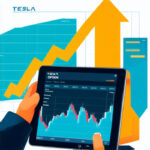Tesla Stock Price: Historical Performance and Future Outlook

Introduction to Tesla Stock Price
Tesla Inc. has become a household name, synonymous with electric vehicles and groundbreaking technology. Tracking the Tesla stock price is crucial for investors and enthusiasts alike, as it reflects not only the company’s financial health but also investor sentiment and market trends. Understanding the historical performance and future outlook of Tesla stock can provide valuable insights for making informed investment decisions. In this blog post, we will delve into the journey of Tesla’s stock price from its inception to its current standing, and explore what the future might hold for this dynamic company.
Overview of Tesla Inc.
Tesla Inc., founded in 2003 by Martin Eberhard and Marc Tarpenning, has grown under the leadership of Elon Musk to become a leader in the electric vehicle market. Headquartered in Palo Alto, California, Tesla’s mission is to accelerate the world’s transition to sustainable energy. The company designs, manufactures, and sells electric vehicles, energy storage solutions, and solar products. Over the years, Tesla has expanded its product lineup and technological capabilities, making it a significant player in the automotive and energy sectors. This growth has been reflected in the fluctuating but generally upward-trending Tesla stock price.
Early Years of Tesla Stock Price
Initial Public Offering (IPO) in 2010
Tesla went public on June 29, 2010, with an initial public offering (IPO) price of $17 per share. The IPO raised approximately $226 million, marking the beginning of its journey as a publicly traded company. The excitement around Tesla’s innovative approach to electric vehicles attracted considerable investor interest. The stock price saw an immediate boost, closing at $23.89 on its first day of trading. This early success laid the foundation for Tesla’s future growth in the stock market, setting the stage for a decade of significant developments and milestones.
Stock Performance in the First Five Years
In the first five years following its IPO, Tesla’s stock price experienced both highs and lows. Initial skepticism about the viability of electric vehicles and production capabilities caused some volatility. However, the successful launch of the Model S in 2012 began to change investor perceptions. By mid-2013, Tesla’s stock price had surged past $100 per share, fueled by strong sales and positive reviews. Despite occasional setbacks, such as production delays and financial losses, Tesla’s stock price showed a general upward trend, reflecting growing investor confidence in the company’s long-term potential.
Tesla Stock Price During Major Milestones
Introduction of Model S and Model X
The introduction of the Model S in 2012 and the Model X in 2015 were significant milestones for Tesla. The Model S, a luxury sedan, received critical acclaim for its performance, safety, and innovative features. Its success helped boost Tesla’s stock price, as it demonstrated the company’s ability to produce high-quality electric vehicles. The launch of the Model X, an all-electric SUV, further cemented Tesla’s reputation. Although the Model X faced some production challenges, its unique features and strong demand positively impacted Tesla’s stock price, contributing to its overall growth during this period.
Gigafactory Announcements
In 2014, Tesla announced plans for its first Gigafactory, a large-scale battery manufacturing facility aimed at reducing production costs and supporting the company’s expansion. The Gigafactory, located in Nevada, became operational in 2016 and played a crucial role in Tesla’s growth strategy. Subsequent announcements of additional Gigafactories in Shanghai, Berlin, and Texas further bolstered investor confidence. These facilities were seen as critical to scaling up production and meeting the growing demand for electric vehicles. Each Gigafactory announcement and subsequent progress updates had a positive impact on Tesla’s stock price, signaling the company’s commitment to long-term growth.
Autopilot and Full Self-Driving Developments
Tesla’s advancements in Autopilot and Full Self-Driving (FSD) technology have been key drivers of its stock price. Introduced in 2014, Autopilot is an advanced driver-assistance system that enhances safety and convenience. Over the years, Tesla has continued to improve its Autopilot features, with the goal of achieving fully autonomous driving. In 2019, Tesla launched its FSD package, offering additional capabilities and promising future updates. These technological advancements have attracted significant investor interest, as they represent a potential game-changer in the automotive industry. Positive developments and updates related to Autopilot and FSD have consistently boosted Tesla’s stock price.
Tesla Stock Price in Recent Years
Impact of Model 3 and Model Y
The launches of the Model 3 in 2017 and the Model Y in 2020 were pivotal moments for Tesla. The Model 3, a more affordable electric sedan, aimed to bring electric vehicles to the mass market. Its success was instrumental in driving Tesla’s stock price to new heights. The Model Y, a compact SUV, further expanded Tesla’s product lineup and appealed to a broader customer base. Strong sales figures and positive reviews for both models significantly contributed to Tesla’s stock price growth, reinforcing the company’s position as a market leader in electric vehicles.
Stock Splits and Their Effects
Tesla has executed two stock splits in its history, both of which had notable effects on its stock price. The first split occurred in August 2020, when Tesla announced a 5-for-1 stock split. This move aimed to make Tesla’s shares more accessible to retail investors. The announcement led to a surge in demand, driving the stock price higher. In March 2022, Tesla announced a 3-for-1 stock split, further increasing accessibility. Both stock splits generated significant investor interest and contributed to short-term increases in Tesla’s stock price, reflecting positive market sentiment and confidence in the company’s future prospects.
Performance During the COVID-19 Pandemic
The COVID-19 pandemic presented challenges for many companies, but Tesla demonstrated resilience. Despite temporary factory closures and supply chain disruptions, Tesla managed to achieve record deliveries and strong financial performance. The company’s ability to navigate the pandemic and continue growing had a positive impact on its stock price. Investor confidence was further boosted by Tesla’s inclusion in the S&P 500 index in December 2020. Throughout the pandemic, Tesla’s stock price experienced significant volatility, but the overall trend remained upward, highlighting the company’s robust business model and growth potential.
Factors Influencing Tesla Stock Price
Market Trends and Competitors
Tesla’s stock price is influenced by broader market trends and the competitive landscape. The increasing demand for electric vehicles and the shift towards sustainable energy solutions have positively impacted Tesla. However, competition from established automakers and new entrants poses challenges. Companies like Ford, General Motors, and Rivian are investing heavily in electric vehicles, which could affect Tesla’s market share. Staying ahead of competitors through innovation and maintaining a strong brand image are crucial for Tesla’s stock price. Market trends, such as changes in consumer preferences and technological advancements, also play a significant role in shaping investor sentiment.
Regulatory Changes and Government Incentives
Regulatory changes and government incentives are critical factors affecting Tesla’s stock price. Policies promoting electric vehicle adoption, such as tax credits and subsidies, can drive demand for Tesla’s products. Conversely, changes in regulations or the removal of incentives could negatively impact sales. Environmental regulations and emissions standards also play a role, as stricter requirements can boost the appeal of electric vehicles. Tesla’s ability to navigate and adapt to regulatory environments in different markets is essential for its growth. Investors closely monitor these factors, as they can significantly influence Tesla’s stock price and overall market performance.
Technological Innovations and Product Launches
Technological innovations and product launches are key drivers of Tesla’s stock price. The company’s continuous focus on improving battery technology, vehicle performance, and autonomous driving capabilities keeps it at the forefront of the industry. Significant product launches, such as the upcoming Cybertruck and the Tesla Semi, generate excitement and can lead to stock price increases. Additionally, advancements in energy storage solutions and solar products contribute to Tesla’s growth prospects. Investors look for signs of innovation and new product developments, as these factors indicate Tesla’s ability to maintain its competitive edge and drive future growth.
Future Outlook for Tesla Stock Price
Predictions from Financial Analysts
Financial analysts have varied predictions for Tesla’s stock price, reflecting differing views on the company’s future prospects. Some analysts are optimistic, citing Tesla’s strong growth potential, innovative products, and expansion plans. They predict significant stock price increases over the next few years. Others are more cautious, pointing to potential challenges such as increased competition, regulatory hurdles, and production constraints. These analysts suggest that Tesla’s stock price may experience volatility but could still offer attractive returns in the long term. Investors should consider a range of analyst opinions and conduct their own research when evaluating Tesla’s future outlook.
Potential Impact of Upcoming Products
Upcoming products like the Cybertruck, Tesla Semi, and the rumored compact car are expected to have a significant impact on Tesla’s stock price. The Cybertruck, with its unique design and impressive specifications, has already generated substantial interest and pre-orders. The Tesla Semi aims to revolutionize the trucking industry with its electric powertrain and advanced features. A more affordable compact car could further expand Tesla’s market reach. Successful launches and strong demand for these products could drive Tesla’s stock price higher. However, delays or production issues could negatively affect investor sentiment and stock performance.
Expansion Plans and Market Penetration
Tesla’s expansion plans and market penetration strategies are crucial for its future growth. The company is focusing on increasing production capacity through new Gigafactories and expanding its presence in key markets such as China and Europe. Success in these regions could significantly boost Tesla’s sales and stock price. Additionally, Tesla’s efforts to improve its energy storage solutions and solar products could open new revenue streams. The company’s ability to execute its expansion plans and effectively penetrate new markets will be closely watched by investors, as these factors will play a vital role in determining Tesla’s long-term stock price performance.
Investment Strategies for Tesla Stock Price
Long-term vs. Short-term Investment
When considering investment strategies for Tesla stock, investors need to decide between long-term and short-term approaches. Long-term investors focus on Tesla’s growth potential and are willing to hold the stock through market fluctuations. They believe in the company’s vision and expect substantial returns over several years. Short-term investors, on the other hand, aim to capitalize on price volatility and make quick profits. Both strategies have their merits, but they come with different levels of risk. It’s essential for investors to align their investment strategy with their financial goals and risk tolerance when investing in Tesla stock.
Risk Assessment and Management
Investing in Tesla stock involves certain risks, and it’s crucial for investors to conduct thorough risk assessments and implement risk management strategies. Key risks include market volatility, competition, regulatory changes, and production challenges. Diversification is a common risk management strategy, where investors spread their investments across different assets to mitigate potential losses. Staying informed about Tesla’s performance, industry trends, and market conditions can also help investors make better decisions. Understanding and managing risks is essential for maximizing returns and minimizing potential losses when investing in Tesla stock.
Diversification and Portfolio Integration
Diversification is a vital aspect of a well-balanced investment portfolio. While Tesla stock offers attractive growth potential, it’s important not to put all your eggs in one basket. Investors should consider integrating Tesla stock into a diversified portfolio that includes a mix of asset classes, industries, and geographic regions. This approach can help reduce overall risk and enhance potential returns. By balancing high-growth stocks like Tesla with more stable investments, investors can achieve a more resilient portfolio. Proper diversification and portfolio integration are key to managing risk and achieving long-term financial goals.
Conclusion
Tesla’s stock price has experienced a remarkable journey since its IPO in 2010, driven by innovative products, technological advancements, and strategic expansion. The company’s ability to navigate challenges and capitalize on opportunities has contributed to its impressive stock performance. Looking ahead, Tesla’s future outlook remains promising, with upcoming products and expansion plans expected to drive growth. However, investors should be mindful of potential risks and consider a diversified investment strategy. By understanding Tesla’s historical performance and future prospects, investors can make informed decisions and position themselves for success in the dynamic world of stock investing.

Laura Henderson is an enthusiast and has been writing on cutting-edge topics for years.







